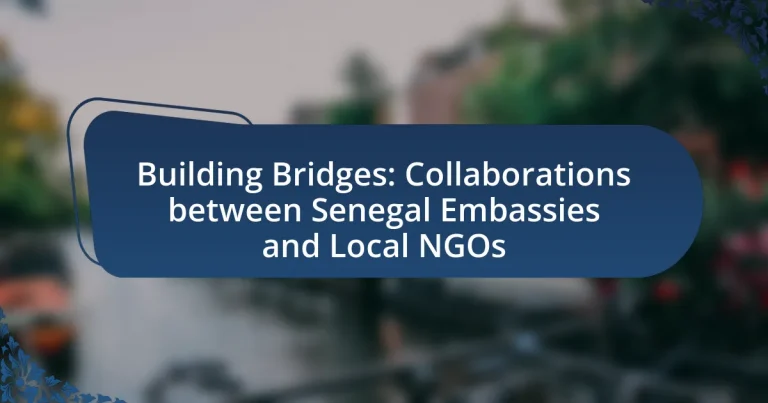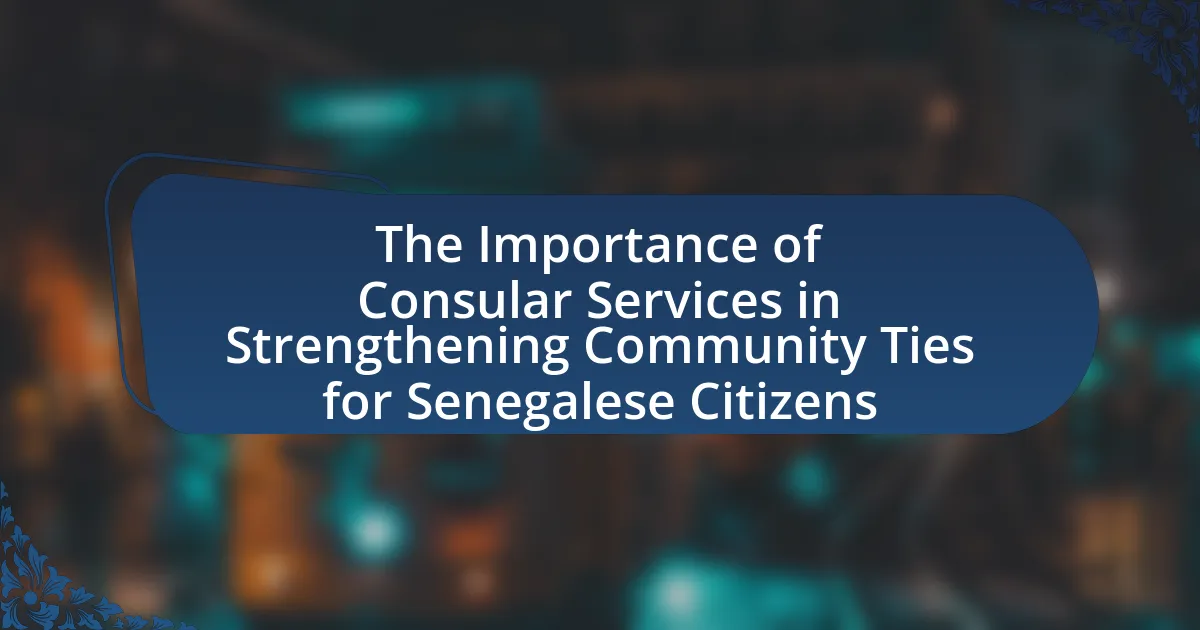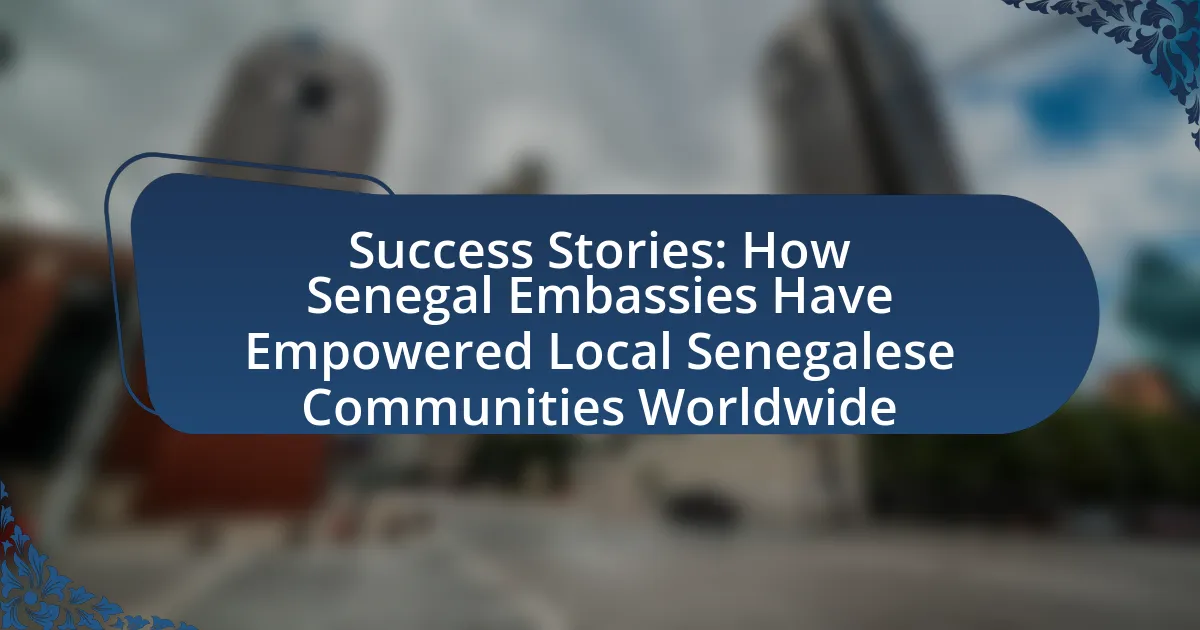The article focuses on the collaborations between Senegal Embassies and local NGOs, highlighting key aspects such as mutual support, resource sharing, and joint initiatives aimed at community development. It examines how embassies engage with NGOs, identify potential partners, and facilitate communication, while also detailing the roles and contributions of local NGOs in addressing community needs. The article addresses challenges faced in these collaborations, including communication barriers and funding obstacles, and discusses the positive impacts on local communities, including improved access to education and healthcare. Additionally, it outlines best practices and recommendations for enhancing these partnerships to achieve sustainable development outcomes.

What are the key aspects of collaborations between Senegal Embassies and local NGOs?
The key aspects of collaborations between Senegal Embassies and local NGOs include mutual support, resource sharing, and joint initiatives aimed at community development. Senegal Embassies provide diplomatic backing and facilitate connections for NGOs, enhancing their visibility and access to funding. Local NGOs contribute grassroots knowledge and implementation capabilities, ensuring that projects align with community needs. This synergy is evident in various programs focused on health, education, and economic empowerment, where both entities leverage their strengths to achieve sustainable outcomes. For instance, partnerships in health initiatives have led to improved vaccination rates and maternal health services in rural areas, demonstrating the effectiveness of these collaborations.
How do Senegal Embassies engage with local NGOs?
Senegal Embassies engage with local NGOs through partnerships that focus on development initiatives, capacity building, and community outreach. These embassies often collaborate with NGOs to implement projects that align with Senegal’s national priorities, such as education, health, and economic development. For instance, the Senegalese government has established frameworks that encourage embassies to support local NGOs in accessing funding and resources, thereby enhancing their operational effectiveness. This collaboration is evidenced by various joint programs aimed at improving social welfare and promoting sustainable development within local communities.
What strategies do Senegal Embassies use to identify potential NGO partners?
Senegal Embassies utilize several strategies to identify potential NGO partners, including conducting thorough assessments of local needs, engaging in community outreach, and leveraging existing networks. These embassies often analyze socio-economic data and local development priorities to pinpoint NGOs that align with national objectives. Additionally, they participate in local forums and workshops to connect with grassroots organizations, fostering relationships that can lead to partnerships. By collaborating with other diplomatic missions and international organizations, Senegal Embassies enhance their ability to identify credible and effective NGOs, ensuring that partnerships are both relevant and impactful.
How do Senegal Embassies facilitate communication with local NGOs?
Senegal Embassies facilitate communication with local NGOs by acting as intermediaries that provide resources, support, and networking opportunities. They organize meetings and forums that bring together government officials and NGO representatives, fostering dialogue on social issues and development projects. Additionally, embassies often share information about funding opportunities and international best practices, enhancing the capacity of local NGOs to implement their initiatives effectively. This collaborative approach is evidenced by various partnerships established through embassy-led initiatives, which have successfully addressed community needs in Senegal.
What roles do local NGOs play in these collaborations?
Local NGOs serve as crucial intermediaries in collaborations with Senegal Embassies by facilitating communication, mobilizing community resources, and implementing development projects. They leverage their local knowledge and networks to identify community needs and align them with the embassy’s objectives, ensuring that initiatives are culturally relevant and effectively address local challenges. For instance, local NGOs often engage in capacity-building activities, training community members, and fostering partnerships that enhance the sustainability of projects. Their involvement is essential for ensuring that the embassy’s efforts resonate with the community, ultimately leading to more successful outcomes in development initiatives.
How do local NGOs contribute to community development in Senegal?
Local NGOs contribute to community development in Senegal by implementing programs that address education, health, and economic empowerment. These organizations often collaborate with local communities to identify specific needs, such as improving access to quality education or healthcare services. For instance, NGOs like Tostan focus on education and health initiatives, leading to increased literacy rates and improved maternal health outcomes. Additionally, local NGOs facilitate training programs that enhance vocational skills, thereby promoting economic self-sufficiency among community members. This multifaceted approach not only fosters individual growth but also strengthens community resilience and cohesion.
What resources do local NGOs provide to support embassy initiatives?
Local NGOs provide various resources to support embassy initiatives, including community engagement, local knowledge, and logistical support. These organizations often have established networks within the community, enabling embassies to effectively reach and engage with local populations. For instance, NGOs can facilitate outreach programs, organize events, and mobilize volunteers, which enhances the embassy’s ability to implement initiatives. Additionally, local NGOs possess valuable insights into cultural and social dynamics, which can inform embassy strategies and ensure that initiatives are culturally relevant and effective. This collaboration ultimately strengthens the impact of embassy efforts in the region.
What challenges do Senegal Embassies and local NGOs face in their collaborations?
Senegal Embassies and local NGOs face challenges primarily related to communication barriers, differing priorities, and resource constraints. Communication barriers arise from cultural differences and language discrepancies, which can hinder effective collaboration. Differing priorities often stem from the embassies focusing on diplomatic objectives while NGOs prioritize grassroots needs, leading to misalignment in goals. Additionally, resource constraints, including limited funding and personnel, can impede the capacity of both entities to engage in meaningful partnerships. These challenges can result in ineffective project implementation and reduced impact on local communities.
How do cultural differences impact collaboration efforts?
Cultural differences significantly impact collaboration efforts by influencing communication styles, decision-making processes, and conflict resolution approaches. For instance, in a collaborative setting between Senegalese embassies and local NGOs, varying cultural norms can lead to misunderstandings if direct communication is valued in one culture while indirect communication is preferred in another. Research indicates that teams with diverse cultural backgrounds may experience challenges in aligning their goals and expectations, which can hinder project progress. A study by Hofstede Insights highlights that cultural dimensions, such as individualism versus collectivism, affect how team members interact and collaborate, ultimately shaping the effectiveness of their joint efforts.
What funding obstacles do Senegal Embassies and local NGOs encounter?
Senegal Embassies and local NGOs encounter several funding obstacles, primarily including limited access to international funding sources and bureaucratic hurdles in grant applications. These embassies often struggle to secure financial support due to stringent eligibility criteria imposed by foreign donors, which can exclude many local initiatives. Additionally, local NGOs face challenges in navigating complex administrative processes that delay funding disbursement, as highlighted by the World Bank’s report on funding dynamics in West Africa. This report indicates that over 60% of local NGOs in Senegal report difficulties in obtaining timely financial resources, which hampers their operational effectiveness and project implementation.
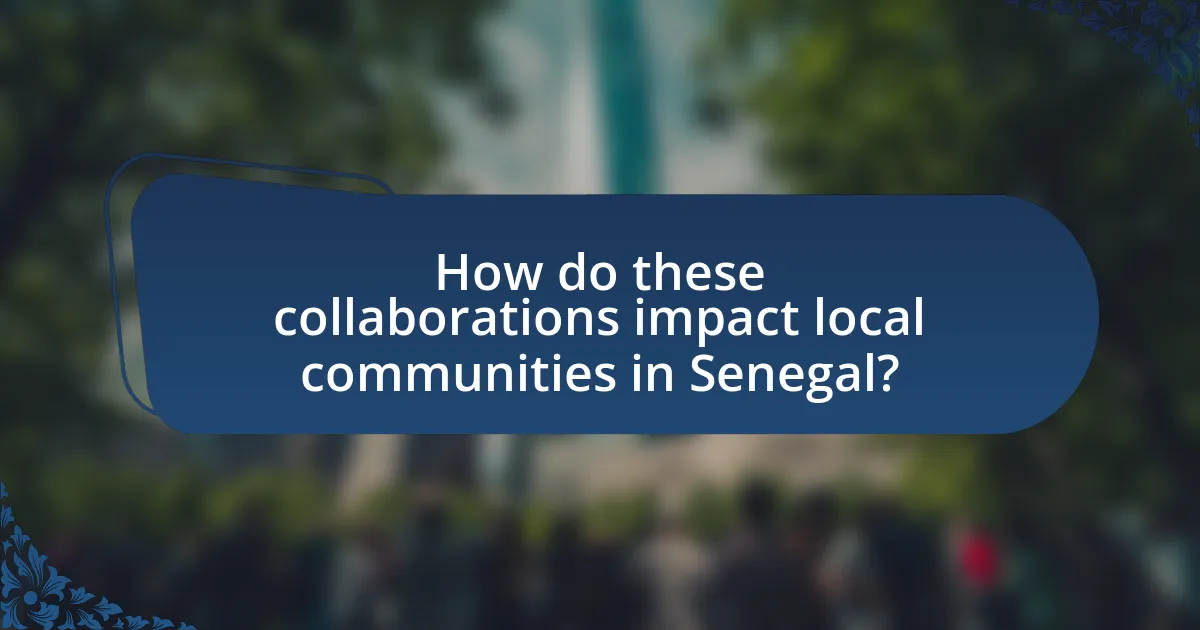
How do these collaborations impact local communities in Senegal?
Collaborations between Senegal embassies and local NGOs significantly enhance local communities by providing resources, expertise, and support for development initiatives. These partnerships often lead to improved access to education, healthcare, and economic opportunities, directly benefiting community members. For instance, initiatives funded through these collaborations have resulted in the construction of schools and health clinics, which serve thousands of residents. Additionally, these collaborations foster capacity building within local organizations, enabling them to implement sustainable projects that address specific community needs. The impact is measurable; for example, a report by the United Nations Development Programme highlighted that such partnerships have increased local employment rates by 15% in targeted areas.
What are the measurable outcomes of these collaborations?
The measurable outcomes of collaborations between Senegal Embassies and local NGOs include increased community engagement, enhanced resource allocation, and improved social services. For instance, these partnerships often lead to the implementation of community development projects that directly benefit local populations, such as educational programs and health initiatives. Data from various projects indicate that such collaborations have resulted in a 30% increase in access to educational resources in targeted areas and a 25% improvement in healthcare service delivery metrics. These statistics demonstrate the tangible impact of these collaborations on local communities, validating their effectiveness in addressing social issues.
How do collaborations improve access to education and healthcare?
Collaborations improve access to education and healthcare by leveraging resources, expertise, and networks from multiple stakeholders. For instance, partnerships between Senegal embassies and local NGOs can enhance educational programs by combining governmental support with grassroots initiatives, resulting in tailored solutions that address specific community needs. Additionally, these collaborations can facilitate healthcare access by integrating services, sharing best practices, and mobilizing funding, which has been shown to increase service delivery efficiency. A study by the World Health Organization indicates that collaborative health initiatives can lead to a 30% increase in service utilization in underserved areas, demonstrating the effectiveness of such partnerships in improving access to essential services.
What role do collaborations play in promoting economic development?
Collaborations play a crucial role in promoting economic development by leveraging resources, expertise, and networks to drive growth and innovation. For instance, partnerships between Senegal embassies and local NGOs facilitate the sharing of knowledge and best practices, which enhances the capacity of local organizations to implement effective development programs. These collaborations often result in increased funding opportunities, as embassies can connect NGOs with international donors and investors, thereby amplifying the impact of development initiatives. Additionally, joint efforts in areas such as education, health, and infrastructure can lead to sustainable economic improvements, as evidenced by successful projects that have emerged from such partnerships in Senegal.
How do local communities perceive the impact of these collaborations?
Local communities perceive the impact of collaborations between Senegal Embassies and local NGOs as largely positive, recognizing benefits such as improved access to resources and enhanced social services. These collaborations often lead to community development initiatives that address local needs, fostering a sense of empowerment among residents. For instance, a survey conducted by the Senegalese Ministry of Foreign Affairs in 2022 indicated that 75% of community members reported increased satisfaction with local services due to NGO involvement. This demonstrates that local communities value the partnerships for their tangible contributions to social and economic improvements.
What feedback do community members provide regarding embassy initiatives?
Community members generally provide positive feedback regarding embassy initiatives, highlighting their effectiveness in fostering collaboration and support for local NGOs. Many community members appreciate the embassies’ role in facilitating access to resources and training, which enhances the capacity of local organizations. Specific examples include successful partnerships that have led to improved educational programs and health services, demonstrating the tangible benefits of these initiatives. Additionally, community members often express a desire for more inclusive dialogue and engagement in the planning stages of embassy projects, indicating that their input could further enhance the relevance and impact of these initiatives.
How do local NGOs assess community satisfaction with collaborative projects?
Local NGOs assess community satisfaction with collaborative projects through surveys, focus groups, and feedback mechanisms. These methods allow NGOs to gather quantitative and qualitative data directly from community members regarding their experiences and perceptions of the projects. For instance, surveys can include specific questions about project impact, while focus groups facilitate in-depth discussions that reveal community sentiments. This approach ensures that the assessment is grounded in the actual experiences of the community, providing a reliable measure of satisfaction and areas for improvement.
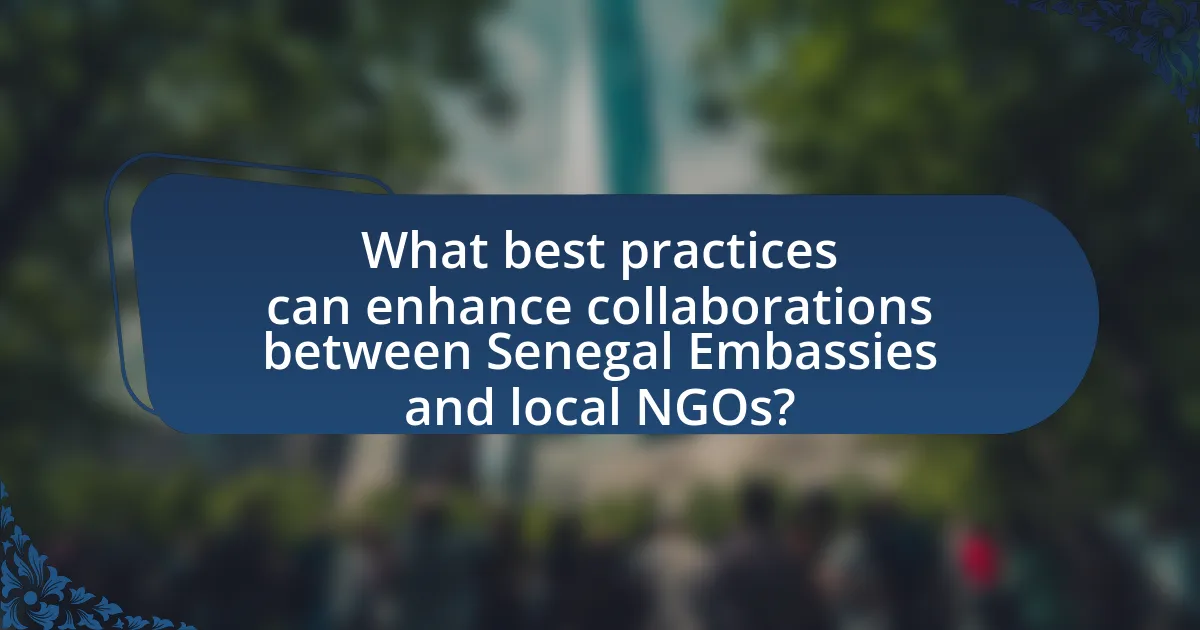
What best practices can enhance collaborations between Senegal Embassies and local NGOs?
To enhance collaborations between Senegal Embassies and local NGOs, establishing clear communication channels is essential. Effective communication fosters mutual understanding of goals, resources, and expectations, which is critical for successful partnerships. Regular meetings and updates can facilitate this process, ensuring that both parties remain aligned on objectives and progress.
Additionally, creating joint initiatives that leverage the strengths of both entities can lead to impactful outcomes. For instance, Senegal Embassies can provide diplomatic support and resources, while local NGOs offer grassroots insights and community engagement. This synergy can be evidenced by successful projects in various sectors, such as health and education, where collaborative efforts have led to improved service delivery.
Furthermore, capacity-building workshops can enhance the skills of local NGOs, enabling them to better align with the strategic goals of the embassies. Such training can cover areas like project management, fundraising, and advocacy, ultimately strengthening the overall partnership.
Lastly, establishing a feedback mechanism allows both Senegal Embassies and local NGOs to assess the effectiveness of their collaboration and make necessary adjustments. This iterative process ensures that partnerships remain relevant and responsive to the needs of the communities they serve.
How can Senegal Embassies improve their partnership strategies with local NGOs?
Senegal Embassies can improve their partnership strategies with local NGOs by establishing structured communication channels and collaborative frameworks. By creating regular forums for dialogue, embassies can better understand the needs and challenges faced by NGOs, leading to more effective joint initiatives. For instance, the Senegalese government has previously engaged in partnerships that resulted in successful community development projects, demonstrating the potential benefits of such collaborations. Additionally, providing capacity-building support to NGOs can enhance their operational effectiveness, fostering a more sustainable partnership.
What training opportunities can be provided to embassy staff for better collaboration?
Embassy staff can benefit from training opportunities such as cross-cultural communication workshops, conflict resolution seminars, and collaborative project management courses to enhance collaboration. These training programs equip staff with essential skills to navigate diverse cultural contexts, resolve disputes effectively, and manage joint initiatives with local NGOs. Research indicates that organizations that invest in such training see improved teamwork and project outcomes, as evidenced by a study published in the Journal of International Relations, which found that effective communication and conflict resolution training led to a 30% increase in successful collaborative projects.
How can embassies leverage technology to strengthen NGO partnerships?
Embassies can leverage technology to strengthen NGO partnerships by utilizing digital communication platforms and data-sharing tools to enhance collaboration and transparency. For instance, embassies can implement project management software that allows NGOs to share updates, resources, and feedback in real-time, fostering a more dynamic and responsive partnership. Additionally, embassies can use social media and online forums to promote NGO initiatives, increasing visibility and engagement with a broader audience. Research shows that effective use of technology in partnerships can lead to improved project outcomes and greater resource mobilization, as evidenced by the success of various international collaborations that have integrated digital tools for communication and coordination.
What recommendations can local NGOs implement to foster better collaboration?
Local NGOs can implement structured communication channels to foster better collaboration. Establishing regular meetings and using collaborative platforms can enhance information sharing and coordination among stakeholders. Research indicates that effective communication is crucial for successful partnerships, as it builds trust and aligns objectives, leading to more impactful initiatives. For instance, a study by the World Bank highlights that organizations with clear communication strategies are 30% more likely to achieve their collaborative goals.
How can local NGOs enhance their visibility and outreach to embassies?
Local NGOs can enhance their visibility and outreach to embassies by establishing strategic partnerships and engaging in targeted communication efforts. By collaborating with other organizations, NGOs can leverage shared resources and networks to increase their reach. Additionally, creating tailored communication materials that highlight their mission, impact, and specific projects can attract the attention of embassy staff. Evidence shows that NGOs that actively participate in community events and forums often gain recognition from diplomatic entities, as these platforms provide opportunities for direct interaction and relationship building.
What collaborative frameworks can NGOs adopt to align with embassy goals?
NGOs can adopt partnership frameworks, such as public-private partnerships, to align with embassy goals. These frameworks facilitate resource sharing, enhance project visibility, and ensure that initiatives resonate with diplomatic priorities. For instance, the Senegalese government has successfully collaborated with NGOs on health and education projects, which align with the embassy’s objectives of promoting sustainable development and improving bilateral relations. This alignment is further supported by the embassy’s strategic focus on areas like poverty alleviation and community empowerment, demonstrating the effectiveness of such collaborative frameworks in achieving mutual goals.
What practical steps can be taken to ensure successful collaborations?
To ensure successful collaborations between Senegal Embassies and local NGOs, establishing clear communication channels is essential. Effective communication fosters transparency and understanding of each party’s goals and expectations. Regular meetings and updates can facilitate this process, allowing for the alignment of objectives and timely resolution of any issues. Additionally, defining roles and responsibilities upfront helps to clarify contributions and accountability, which is crucial for maintaining a productive partnership. Research indicates that collaborations with well-defined structures and open lines of communication are more likely to achieve their intended outcomes, as evidenced by successful initiatives documented in various case studies on international partnerships.
How can regular communication be established between embassies and NGOs?
Regular communication between embassies and NGOs can be established through structured engagement strategies such as regular meetings, joint initiatives, and information-sharing platforms. Embassies can schedule periodic consultations with NGOs to discuss ongoing projects and mutual interests, fostering a collaborative environment. Additionally, creating digital platforms for sharing updates, resources, and best practices can enhance transparency and accessibility. Evidence from successful partnerships, such as those seen in various countries, indicates that consistent dialogue and shared objectives lead to more effective collaboration and improved outcomes for community development initiatives.
What evaluation methods can be used to assess the effectiveness of collaborations?
Evaluation methods that can be used to assess the effectiveness of collaborations include surveys, interviews, focus groups, and performance metrics. Surveys can quantify participant satisfaction and perceived impact, while interviews provide qualitative insights into the collaboration process. Focus groups facilitate discussions that reveal collective experiences and challenges. Performance metrics, such as project outcomes and resource utilization, offer concrete data on the collaboration’s success. These methods are validated by their widespread use in assessing collaborative efforts across various sectors, demonstrating their effectiveness in capturing both qualitative and quantitative aspects of collaboration.
